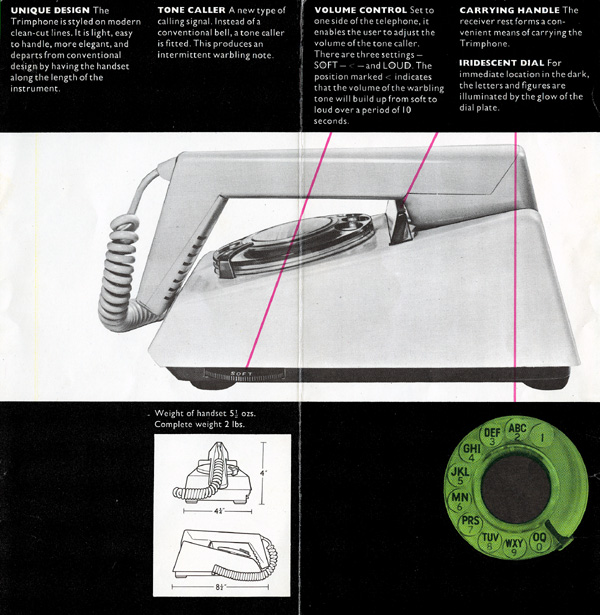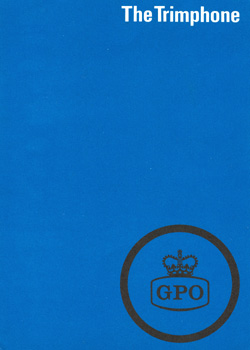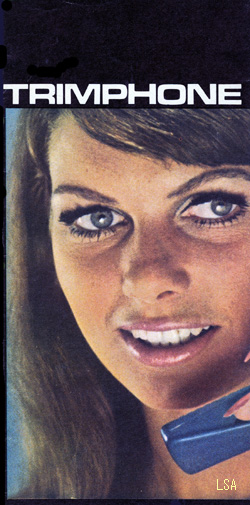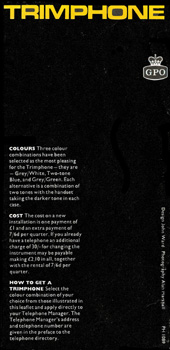|
GPO TRIMPHONES |
This fold-out leaflet was effectively used to market the
TRIMPHONE in the late 1960s, when the GPO ran the UK
telephone services.
Its matt finish is very
minimalist, giving the impression of clean, simple lifestyle
with colour tones which would blend in and not look out of
place in almost any decor. (Unlike the later Phoenixphones
which used bold, brave, almost garish colours to get
noticed). Of course, the late 1960s and early 1970s were
about crisp, sharp ideas, exploiting the latest developments
in technology and the application of modern plastics. The
Trimphone was very much ahead of its time; the casing was a
very modern stylish design, but the necessary electronic
components had not yet caught up. It was a compromise
between function and style to fit all the workings into such
a small case. But make no mistake, the Trimphone was a very
cleverly engineered phone and although it had some design
faults, many models are still in use today, when more modern, cheaper phones have been consigned to the bin.
GPO Leaflet PH1089 -
Design John Ward, Photography Alan Marshall.
|
|
|
Style
A neat, stylish, lightweight handset, easy to hold and untiring on the
arm for those long chats on the phone. The Trimphone was a fashion
statement, not something to be hidden away. To facilitate comfortable
telephoning, the Trimphone had a long stretchy (helical) matching colour
line cord. Remember, modern PST sockets did not appear until the late
Seventies. Even so, apart from the standard hard-wired installations,
the Trimphone could be also supplied on Plan 4 (old style round plugs)
systems and shared service lines.
Leaflets |
TRIMPHONE | The Trimphone
|
"Trimphone represents a new luxury in telephones.
Easily handled, the sensibly compact styling is the result of a
completely original design created in conjunction with the Council of
Industrial Design."
Wow, a choice of 3 colour tones to match in with any decor!
- Two-tone BLUE
- GREY/GREEN
- GREY/WHITE
|
Truly, the Trimphone looked great and deserves a place with the classic
designs of the 20th century.
TRIMPHONE
COLOURS
"Three colour combinations have been selected as the most pleasing
for the Trimphone-they are- Grey/White, Two-tone Blue, and Grey Green.
Each alternative is a combination of two tones with the handset taking
the darker tone in each case."
COST
"The cost on a new installation is one payment of £1 and an extra
payment of 7/6d per quarter. If you already have a telephone an
additional charge of 30/- for changing the instrument may be payable
making £2 10 in all, together with the rental of 7/6d per quarter."
HOW TO GET A TRIMPHONE
"Select the colour combination of your choice from those illustrated
in this leaflet and apply directly to your Telephone Manager. The
Telephone Manager's address and telephone number are given in the
preface to the telephone directory."
Note: 12d (old pennies) were equal to 1/- (one shilling) and 20/-
(shillings) used to make £1.
 |
UNIQUE DESIGN The Trimphone is styled on modern clean-cut
lines. It is light, easy to handle, more elegant, and
departs from conventional design by having the handset along
the length of the instrument.
TONE CALLER A new type of calling signal. Instead of a
conventional bell, a tone caller is fitted. This produces an
intermittent warbling note.
VOLUME CONTROL Set to one side of the telephone, it enables
the user to adjust the volume of the tone caller. There are
three settings- SOFT- < -and LOUD. The position marked <
indicates that the volume of the warbling tone will build up
from soft to loud over a period of 10 seconds.
CARRYING HANDLE The receiver rest forms a con- venient means
of carrying the Trimphone.
IRIDESCENT DIAL For immediate location in the dark, the
letters and figures are illuminated by the glow of the dial
plate.
Weight of handset 51/2 ozs. Complete weight 2 lbs.
|
| |
|
The Trimphone
 |
The following notes will help you to use your new telephone
to the best advantage...
The Trimphone uses a 'Tone caller' instead of a bell;
this is an electronic device that gives a high pitched tone,
the volume of which can be adjusted by a control projecting
from the right of the base.
The soft setting gives a
low-intensity note that cannot normally be heard outside of
the room in which the telephone is situated and is really
intended for use only in very quiet situations where there
is always someone in the room.
With the medium setting the
tone starts quietly but quickly gets louder, reaching a
maximum in about ten seconds. This setting is probably best
for general use as someone near the telephone can answer
before the tone becomes loud enough to irritate others but,
if there is no one near, the louder tone, especially on the
loud setting will be heard from quite a long distance away.
There is also an off position for completely disconnecting
the tone caller but this can be used only if there is also a
bell (or another tone caller) on the line.
The telephone may be cleaned with a soft slightly damp cloth
or washleather and finally wiped dry with a soft clean cloth. On
no account should abrasives or spirit cleaners be used.
Dd 36/73139 Ed (3039) A3717 Trimphone
|
Technical Details
The basic dial Trimphone, Tele No.712
was modular in design which enabled key components to be
developed and improved upon as a result of use in the
field...
Tele No.712 used the following components:
- Handset No.8
(based upon Headset No.1)
- Inset Receiver No.3T
- Transmitter No.15
- Circuitry design as per Tele No.706
- Induction Coil No.31
- Regulator No.1A
- Dial Auto No.30FA
- Tone ringer board
Field trials proved that a more reliable set was desirable and so
the Trimphone underwent several development stages:
- 712 Mark II
- 1/722
- 1/722 MOD
- 2/722
Thus by 1982 the 2/722 used:
|
- Handset No.10A-1 (still based upon Headset No.1)
- Inset Receiver No.3T
- Transmitter No.15
- Regulator No.7A
- Circuitry design as per Tele No.746
- Dial Auto No.30FA
- Tone ringer board No.8A
Press-Button Types
|
 |
Press-Button Trimphone-The Trimphone with the modern touch,
so read the publicity leaflet of August 1980.
This was version was much better than the dial Trimphone, it
didn't slip about so much! But then again, it didn't have a
luminous dial to glow in the dark.
Early versions were loop-disconnect or pulse dialling,
otherwise known as SC (self-contained) needing no external
power source. MF or DTMF (dual-tone, multi-frequency) were
to come later as the electronics caught up with the small
sized case.
At last, numbers could be entered into the keypad as quickly
as you could press the buttons. But alas, the pulsed digits
were only sent to the line at 10 i.p.s to allow the Strowger
exchanges time to step the selectors.
Here we look at the early press-button types, through to the
Phoenixphones of later years...
|
| |
|
|
| |
Design, images and text compiled by ©
Light-Straw. Page last updated 5th
March 2011.
Checked June 2021.
All logos and trade marks are the property of their respective owners
and are used on the Light Straw site(s) for review only. Students and
researchers are recommended to make their own independent enquiries as
to the accuracy of the information contained therein. |






